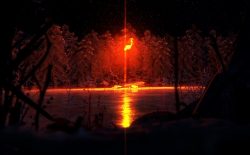Rustan Söderling follows the life cycle of a bewitched bio-mechanical entity caught in a complex interplay between modernity and mythology.
Following on from a haunting procession through a post-apocalyptic landscape transfigured by remerging myths for VISIO’s Youth Grows Forever, artist Rustan Söderling envisions a fresh encounter with ancient magic and modern technology. Virus Meadow follows the life-cycle of an omnivorous, shapeshifting entity as it stalks through a frozen landscape evolving from the spark of an ancient spirit flame to an unsettling reproduction of a humanoid form. Bursting into existence through a frozen lake, through a complex hybrid process of absorption and replication, half earth magic, half extreme osmosis, Söderling’s entity interacts with the hostile environment it finds itself in, as well various objects and lifeforms it encounters along the way. “Through the first of its many iterations it resembles a Will-O-The-Wisp, a flickering faerie light known to lure unassuming travellers from their paths,” explains Söderling. “In an ancient earth temple it morphs into the figure of The Green Man, all tangled root and rotten leaves. In its encounter with an abandoned campsite it merges with the various humdrum trinkets left behind to finally resemble something akin to the Golem of Jewish folklore, an entity formed entirely of inanimate matter. Finally, through its submergence in an icy lake it crawls onto land and inhabits its final humanoid rendition.” Tracing a progression from the natural through the mechanical, the artist builds a speculative lifecycle of a being formed in an environment shaped in equal parts by biological complexity, industrialised production and magical potency.



“I had long been interested in the myth around The Green Man as a kind of nature spirit, or embodied force of the environment, made from both dead and living bio-matter,” continues Söderling. “I happened to read the book Lanny by Max Porter halfway through the process of making the work and it had some quite striking similarities in the character of Dead Papa Toothwort, who is a sort of nature spirit, but also mixes with human debris and trash, a kind of contemporary Frankenstein’s monster. So the idea of a metamorphosing organism started taking shape, something that goes from the natural world into the human through an extended metaphor for human civilisation and myth. We used to be scared of the dark woods, now we’re scared of technology.” As the organism mutates, steadily evolving in a symbiotic relationship with matter both animate and inanimate, the sinister nature of its existence is slowly revealed, not in malevolency, but in its unemotional lifecycle of consumption and expansion, a folk horror doubling of anthropocentric cycles of industrialised consumption which are conspicuously absent from Söderling’s frozen, nightmarish vision of a Disney winter woodland. This revelation is amplified in Alban Schelbert’s intricate score, which takes the phenomena of the hummadruz, a noise in the air that you can’t identify, or a sound in the landscape whose source is unplaceable, as its primary inspiration. Flickering between diegetic and non diegetic sound, Schelbert vocalises the organism in uncanny synthetic textures, blurring the line between electronic sound, polyphonic chorus and indecipherable, speech, as though it is slowly learning to sound like a human.



Finally taking the shape of a human after merging once again from icy waters, the final phase of the organism’s evolution is revealed. “The creature resembles a sort of tragic Pinocchio figure, summoned with no clear purpose or intent, like an accidentally spawned virus at a wet market,” says Söderling. “It shuffles off to its inevitable confrontation with the victims, euphoric revellers of a local rave.” Conceiving of a desolate forest rave as a contemporary ritual, a modern counterpoint to the old world sacrifice we see in the films opening moments, Söderling envisions in Virus Meadow’s climax the catastrophic effects of this collision between modernity and myth. “I think the rave definitely is a sort of modern ritual, a fertility rite, but with a certain death drive,” explains Söderling. “The final humanoid version of the creature has absorbed all the inanimate matter, which constituted the golems body, into its flesh, it has internalised the technology, become one with it, it has become ‘modern,’ but it is still a sort of automaton, like a virus sent on a blind trajectory out into the world in order to find hosts.” In this final encounter, the world takes on the same eerie orange hue as the ancient spirit flame from which the creature was borne, as though this final act of absorption transcends animate and inanimate matter, the loose celebratory energy and hedonistic excess of the rave itself sucked into feed the surging flame that blinds us in the film’s final moments.



For more information about Rustan Söderling and his work you can find him on Instagram and visit his website.
You can find the Virus Meadow OST from Alban Schelbert on SoundCloud. You can find Alban on Instagram.
Watch next: DRONE OPERATØR unleash post digital free jazz chaos with Bot Møther




































